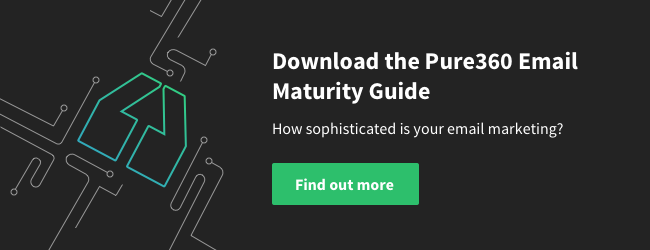Advice is always better when it’s personal. Tailored to your needs and circumstances – from someone who knows what you’re capable of.
We always like to help clients look at what they could be doing differently to improve their performance. We also understand that clients have different business constraints, resources and objectives so we tailor our advice to make sure it’s personal.
We’ve developed the Email Maturity Model – an industry-leading framework of email sophistication which allows you to pinpoint exactly what level of email marketing you’re at and what your next steps should be. The model identifies five ‘types’ of email marketer – all at different stages of sophistication.
In this blog post we’ll be looking at ways to help the type of email marketer we call ‘The Segmenter’.

If you’re a Segmenter you’ve moved beyond the basic ‘batch-and-blast’ approach to email marketing and are beginning to target groups of recipients with relevant content. You still use email as a sales channel but realise its value in driving customer engagement and loyalty – it’s just frustrating that you don’t have the time or resource to explore the potential fully. You want to move towards using your email marketing as a CRM tool but you’re hampered by outdated systems and departments which operate in silos.
We hear a lot of questions from The Segmenter on how they can develop their strategy further to meet both their sales and customer engagement goals. We’ve answered some of the most common to help you take your next steps in your email marketing journey.
Question: How do I make my email content relevant to my customer’s interests?
Answer: Use an email preference centre
Relevant emails drive 18 times more revenue than broadcast emails (Jupiter Research, 2014) but how do you decide what is relevant to your customer? Well if you don’t know their interests then ask them.
A preference centre is a great way of finding out what your customer wants to hear about when you don’t have any information about their interests on your database. When visitors to your website sign-up for your emails, a preference centre provides a simple tick box tool which they can use to select the types of content they’d like to receive. They can even select how often they’d like to hear from you.
It’s a good way make sure you can keep your email content relevant, your audience engaged and don’t waste time sending emails that won’t be read. Recipients love preference centres as it put them in control – marketers love preference centres as they reduce unsubscribe rates. As your emails will contain information which they’ve said they want to receive, recipients will be far more receptive to your messages when they pop into their inbox.
Question: How do I find the extra resource to create personalised emails?
Answer: You don’t need to – use the technology to do it for you
Personalisation doesn’t mean spending hours creating multiple versions of the same email – it means being smart about how you use the technology.
You don’t need to spend hours creating clunky versions of emails to send to a few segments when the technology offers you the ability to automate personal experiences. The beauty of personalisation is that it will undoubtedly add to your bottom line with personalised email generating 14% higher open rates and 10% higher click-through rates. (Aberdeen Group, 2015).
Our Behavioural Targeting solution is a great way to track your customers interests through looking at the online behaviours and actions. It allows you to trigger one-to-one personalised emails as soon as they abandon a purchase, browse a product or don’t fully complete an enquiry form. This personalised approach allows you to target customers when they’re most receptive to your marketing allowing you to increase sales by up to 22%.
Question: How can I get more people to open and engage with my emails?
Answer: Create a simple testing schedule
There’s nothing to lose from testing your email marketing to optimise results. You may think you know certain things but behaviours and interests change over time – especially as technology evolves.
You can test anything – subject lines, send times, copy, images and calls-to-action. A simple A/B test will provide a robust way of telling what is most effective for your audience. Don’t try and test everything at once – set-up a testing schedule with one focus per month and repeat the test a few times within that month.
One of the easiest things to test is your subject line – it’s the deciding factor of whether your email actually gets opened so if you don’t optimise that, it’s difficult to test any content. Don’t forget to use our Subject Line Tester to test keywords, symbols and personalisation to find out what appeals to your audience.
These are just a few basic starting points for a Segmenter wanting to develop their email strategy. With some simple tweaks to what you’re already doing you can increase the engagement of your audience, efficiency of your campaigns and stay on top of the latest trends. And regardless of your resource or times, there’s always opportunity to develop your email marketing to drive better results.

